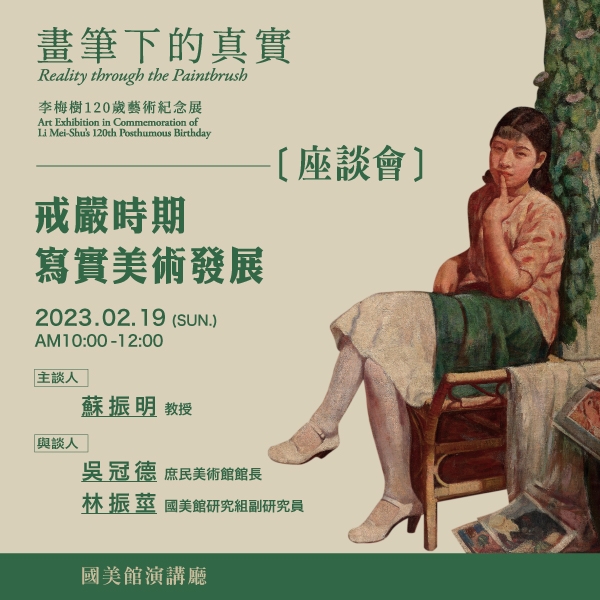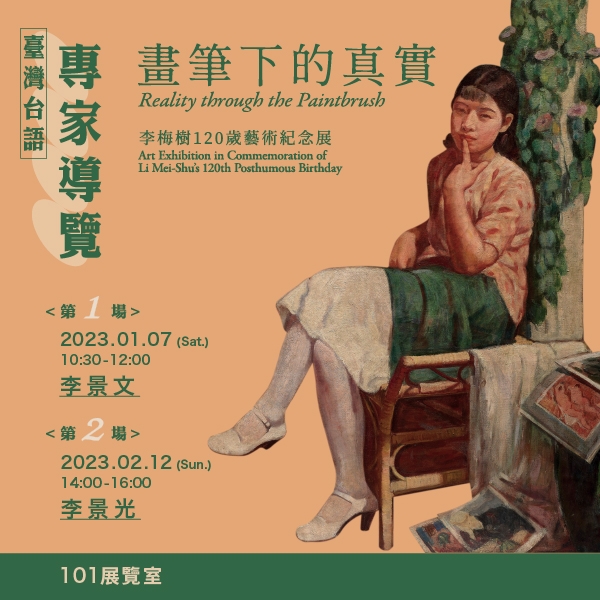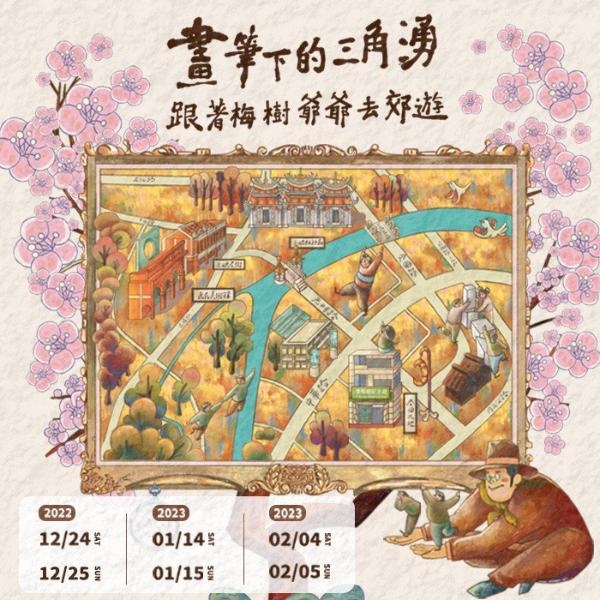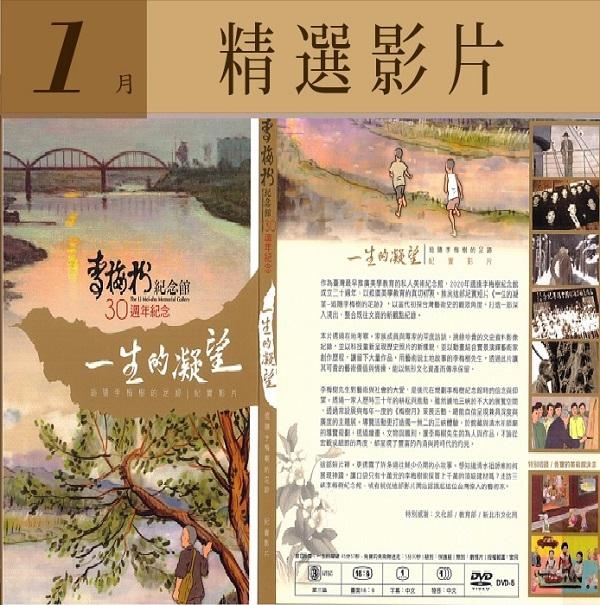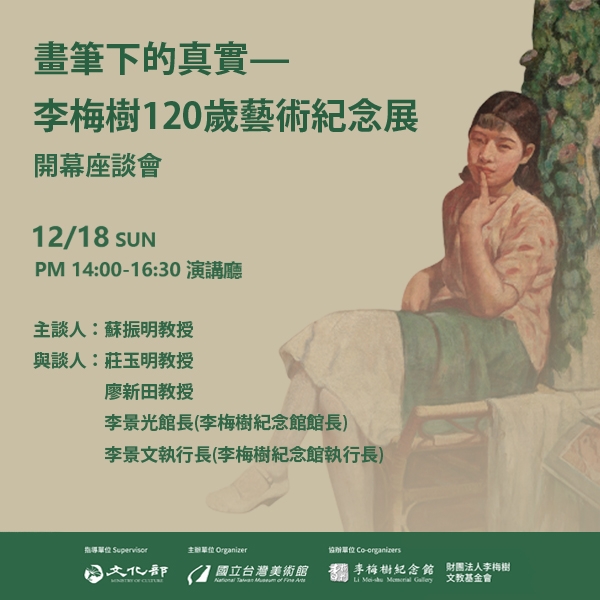| Number of Sessions |
|---|
| Reality through the Paintbrush – Art Exhibition in Commemoration of Li Mei-Shu’s 120th Posthumous Birthday |
-
 Organizer
:
National Taiwan Museum of Fine Arts
Organizer
:
National Taiwan Museum of Fine Arts
Reality through the Paintbrush
– Art Exhibition in Commemoration of Li Mei-Shu's 120th Posthumous Birthday
2022. 12. 17 — 2023. 03. 12
Gallery 101, National Taiwan Museum of Fine Arts
Curator | HSUEH Yen-Ling
Supervisor | Ministry of Culture
Organizer | National Taiwan Museum of Fine Arts
Co-organizers | Li Mei-shu Memorial Gallery, Li Mei-Shu Foundation
Introduction
Li Mei-Shu (1902-1983), who upheld his beliefs and principles throughout his life and insisted on capturing the native land and people of Taiwan through the Realist style, was born in Sanxia (then known as Sann-kak-íng, renamed to Sanxia in 1920). In 1910, he entered Sankakuyu Public School and received Western education. He was admitted to the Teacher Training Department at Taiwan Governor-General's National Language School in 1918, and then went to study abroad in Japan in 1928. The next year, he was admitted to the Western Painting Program, Tokyo Fine Arts School (now Department of Fine Arts, Tokyo University of the Arts), where he was instructed by Pleinairist painters like Nagahara Kotaro, Kobayashi Mango, and Okada Saburosuke, laying a solid foundation for his later Realist style. Since being selected to the First "Taiwan Fine Arts Exhibition" (Taiten) in 1927, Li proactively participated in official art exhibitions in both Taiwan and Japan, and earned 16 selections to Taiten and Futen, and won honors like the "Special Selection Award" or "Governor-General's Award;" he was also selected to the Third “Ministry of Education Art Exhibition” (Shin Bunten) in Japan in 1939 and the "Art Exhibition Celebrating 2600th Anniversary of the Founding of Japan" in 1940. Moreover, Li was an active figure in various painting societies, including the Kofukai Art Association in Japan and Chidao (Red Island) Painting Society and Tai-Yang Art Association in Taiwan. After the war, Li also served as juror of the Provincial Fine Arts Exhibition, displaying his passion for artistic creation and participation in art activities.
Influenced by his father Lee Ching-Yin and eldest brother Liu Ching-Kan (who used the maternal surname) since a young age, Li Mei-Shu not only had great passion for art but was also dedicated to local social welfare and art education, making him one of a few early Taiwanese artists with multiple identities. In addition to his extensive oeuvre, he had also held public and political posts since 1934, including councilor of Sanxia Street, chair of Sanxia Town Council, interim chief of Sanxia Street, chairman of Sanxia Farmers’ Association, and councilor of Taipei County; in 1947, Li Mei-Shu was elected as the head of the restoration project of Qingshui Zushi Temple in Sanxia, thus embarking on a journey that spanned over 30 years. Under his leadership and planning, the temple was restored into an eternal pantheon of religious art. Starting from 1962, Li Mei-Shu also taught at Chinese Culture University, National Taiwan Academy of Arts (now National Taiwan University of Arts), and National Taiwan Normal University, until his retirement in 1977, realizing his close connections with art activities, education, and society.
Li Mei-Shu’s artistic vocabulary originated from Japan’s academic education, as he had solid academic foundation of Realism and was influenced by the Pleinairist outdoor light and shadow, and brushstrokes, of Impressionism, as he studied the Western European styles since late 19th century. After the war, many Taiwanese artists were affected by political and social situations, as well as modern art’s abstract trend, and changed their styles; however, Li Mei-Shu remained unwavering and persisted on his Realist path, where his style began to break away from the Western aesthetic standards. After the 1950s, his gaze on the native soil changed his painting vocabulary, and his style transitioned to become closely tied with Taiwan’s local people, surrounding environments, and local aesthetics, creating works that embodied his own local subjective consciousness. Li Mei-Shu insisted on expressing “reality” with his paintbrush throughout his creative life, as “reality” was what held the belief of beauty and emotional connections together, a belief that was concerned with the display of local terroir.
Li Mei-Shu was a hard-working and prolific artist. From the copies of works by renowned Western artists in his youth, to works during his school years, Zushi Temple related paintings, and his later nativist paintings, Li amassed thousands of paintings, including drawings, oil paintings, watercolor paintings, ink paintings, and drafts, as well as documents. This year (2022) marks the 120th posthumous birthday of Li Mei-Shu, and this exhibition is organized to comb through his life’s work of art and revisit the paintings he created through his paintbrush that depict the native land and document the authentic style of Taiwan with great sincerity. This exhibition has selected the best of his creative works, as well as corresponding draft drawings, photographs, and documents, and grouped the exhibits into six subthemes to present and explore Li Mei-Shu’s creative context, themes, and stylistic characteristics, weaving in between his artistic practices and journey of social engagement.
Artists
OKADA Saburosuke (1869-1939), ISHIKAWA Kinichiro (1871-1945), Li Mei-Shu(1902-1983), Li Shih-Chiao (1908-1995), Liao Chih-Chun (1902-1976), Wu Yao-Chung (1937-1987)
*Listed by birth year
| Attachment(s) | Description of Attachment(s) |
|---|---|
| 「畫筆下的真實—李梅樹120歲紀念展」展覽摺頁 | 「畫筆下的真實—李梅樹120歲紀念展」展覽摺頁 |











